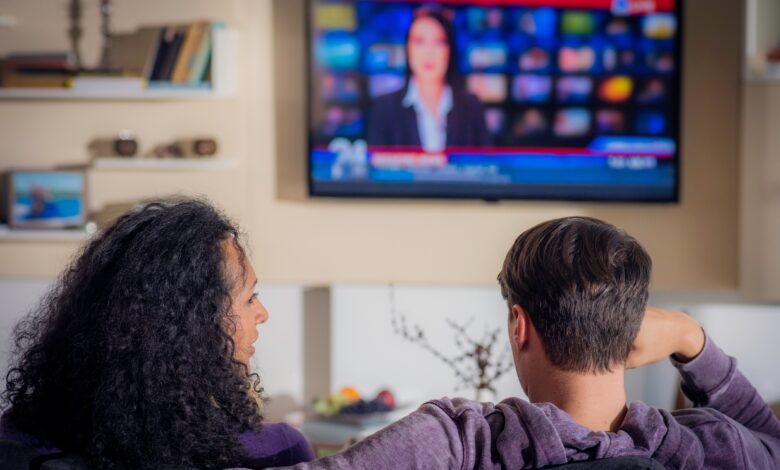The blurred lines between news and narrative: Why trust in mainstream media is declining
When the quest for clicks and ratings leads to sensationalized coverage lacking nuance and factual rigor.

The number of people who trust mainstream media is declining significantly. If you were to ask anyone about their trust in the media, most people would likely express doubt, regardless of their political or ideological standpoint. It seems that everybody has some problem or another with traditional media.
Even journalists from one side accuse journalists from another side of biased reporting, spreading misinformation, and promoting the political ideologies of their masters. Now, even political parties have their favorite journalists and media houses, as well as a list of journalists they want to boycott.
These news anchors have become so narrative-driven that when an event or incident occurs, you can predict which stance each journalist will take.
It is essential to acknowledge that journalism is a complex field, and distinguishing between good journalism and propaganda can be challenging. What one person sees as responsible reporting, another may perceive as biased.
One thing is clear: people’s trust in traditional media, often referred to as mainstream media, is diminishing. This phenomenon is not limited to India but is a global trend supported by several reports.
Although I haven’t come across any credible reports on how many Indians still trust mainstream media, a Digital News Report published by Reuters in 2022 suggests that 42% of Indians trust the media.
A report by Gallup regarding trust in media in the United States states, “Just 7% of Americans have ‘a great deal’ of trust and confidence in the media, and 27% have ‘a fair amount.’ Meanwhile, 28% of U.S. adults say they do not have very much confidence, and 38% have none at all in newspapers, TV, and radio.” A poll by YouGov suggests that Americans trust weather channels the most, which is ironic because weather, not the journalists, used to be considered unreliable.
There have been instances where journalists were discovered either intentionally or unintentionally creating narratives based on false information or lacking empathy while discussing sensitive topics.
There are many reasons why people’s trust in the media is declining. The fault lies not only with journalists but also with users and the system within which the journalism industry operates. These factors include financial incentives, drama, and polarization. Some of the fault also lies with the fact that people are sometimes unwilling to hear what is right; they want their biases reaffirmed.
Let’s explore some key reasons why people may not trust the media as much:
FROM THE JOURNALISTS’ PERSPECTIVE:
- Excessive Opinion, Insufficient Fact: Journalists are expected to be objective and unbiased, but they also have the right to express their opinions. However, problems arise when they inject too much personal opinion into their reporting, overshadowing the factual content and presenting it as news.
- Sensationalism and Clickbait: Many media organizations rely on attracting viewers, readers, or clicks to sustain their business models. This has sometimes led to sensationalism or clickbait tactics that erode trust in pursuit of profit. Topics that could be presented clearly with research often devolve into never-ending debates, with panelists berating each other, sometimes becoming meme material. While it’s not entirely the media’s fault, these types of debates generate high ratings, which translates to revenue.
- Fake News: Media outlets often race to be the first to cover breaking news, seeking to create viral stories. However, the rush to report news can sometimes overshadow fact-checking and reality, leading anchors to confidently spread false information. An example of this was the “chip in 2000 Rupee Note” incident during the demonetization in 2016 when logic took a back seat to sensationalism.
- Accusations of Bias: Accusations of bias in reporting have become increasingly common. Some people believe that media outlets have political or ideological agendas that influence their reporting.
- Increased Awareness Among Audiences and Journalists/Fact-Checkers Being Exposed: In the age of social media and easy access to information, people are more connected and have access to news reporters. Bias, whether toward one side or another, is often evident through journalists’ social media posts. There have also been instances of fact-checkers getting caught spreading fake news, raising questions about their credibility.
- Rise of Social Media Influencers/Educators: With platforms like YouTube, there has been a surge in “edutainment” influencers and educators like Prashant Dhawan, Khan Sir and Vikas Divyakirti etc. They have become a primary source of information for young people due to their more objective teaching styles, as opposed to pushing a particular agenda. They empower people with information.
- Lack of Accountability: News outlets and journalists rarely face major consequences for unethical practices, leading to a perception that they can act with impunity.
- Favoritism Toward Supporter Bases: Many journalists in India are perceived to favor specific ideologies or political parties. Once this perception takes hold, it becomes challenging for them to report on topics that may contradict their core audience’s beliefs. There have been incidents where journalists who attempted this ended up upsetting their core audience and faced criticism.
- Rise of Public Platforms like Twitter and Social Media and Direct Access to Information: With internet access, people can now directly access information from political leaders through platforms like Twitter. This has reduced the need for journalists as intermediaries connecting the public to leaders.
- Overemphasis on Trivial Issues and Neglect of Important Matters: Media outlets often devote disproportionate coverage to celebrity gossip, viral videos, sensational crimes etc. while neglecting crucial societal issues like poverty, healthcare, education, climate change. This imbalance shapes public discourse, causing substantive topics to drop in priority. The over-focus on the trivial at the cost of issues critical to democracy is detrimental.
- Polarizing Political Events: Certain political controversies get covered in highly polarized ways that divide audiences into opposing camps, intensifying ideological divides. Nuance and factual analysis take a backseat to charged rhetoric by anchors and guests. This entrenches biases as people gravitate towards outlets aligning with their perspectives. Polarized coverage of key events in a diverse democracy like India risks heightening community tensions and disrupting social cohesion.
FROM THE SYSTEM’S PERSPECTIVE:
- It is impossible to be entirely unbiased; biases can manifest in various ways, from the choice of topics to the sources quoted, the tone used when discussing something, or the information that is deliberately overlooked. Bias is inherent in journalism, as Friedrich Nietzsche stated, “there are no facts, only interpretations.” While we may not fully embrace this notion, it certainly applies, to some extent, to the field of journalism.
- The media system is incentivized by drama because it generates profits. While we can criticize sensationalism, media outlets continue to engage in it because it attracts viewers and boosts their ratings. In a free-market environment, anything that brings in money is encouraged. These media houses are multi-million-dollar enterprises striving to maximize their earnings.
- Journalism is a poorly compensated industry, often reliant on external funding. However, this external funding can come with strings attached, influencing the narrative. One such case involves the Open Society Foundation, linked to the billionaire George Soros, who has repeatedly supported what he calls “liberal values” and openly criticized elected leaders in other countries as autocratic and more.
FROM THE CONSUMERS’ PERSPECTIVE:
- Confirmation Bias and Other Biases: A significant challenge in today’s media landscape is confirmation bias, where individuals tend to seek out information that aligns with their preexisting beliefs and values. This bias can lead people to consume news and content that reinforces their existing viewpoints while dismissing contradictory information. Confirmation bias, along with other cognitive biases, can hinder critical thinking and open discourse.
- Polarization: Media polarization occurs when news consumers gravitate toward sources that echo their political, ideological, or social leanings. This phenomenon can intensify existing divisions in society, as people engage less with opposing viewpoints and become more entrenched in their own positions. Journalists who challenge these biases may face backlash from their core audiences, leading to name-calling and accusations of bias.
Why We Need Journalists:
In today’s fast-paced world, people have access to vast amounts of information through the internet and direct access from their leaders on social media. But people still often find themselves lacking the time and resources to delve into extensive research on complex issues. Journalists play a crucial role as intermediaries who distill vast amounts of information into understandable narratives. They connect the dots, illustrating how events on the global stage can impact individuals in their daily lives. This context is invaluable in helping the public grasp the significance of news stories.
Journalists also serve as watchdogs, holding governments, corporations, and institutions accountable for their actions. They investigate cases of corruption, abuses of power, and social injustices, serving as a vital check on authority.
- Mainstream media still sets the narrative on many issues due to their extensive reach and resources for in-depth reporting.
- People still trust mainstream media outlets as reliable sources for thoroughly researched information on complex topics.
- Journalists raise crucial issues and speak uncomfortable truths that demand public attention and discussion.
Media Influencers/Independent Journalists: Not as Independent as They Seem
The emergence of independent content creators on platforms like YouTube has offered an alternative to traditional media. These creators, often positioning themselves as impartial educators, have garnered sizable followings. However, it’s essential to acknowledge that they, too, employ tactics that can shape public opinion:
TACTICS EMPLOYED BY INDEPENDENT CONTENT CREATORS:
- Deliberate Omission or Downplaying of Facts: They may choose to omit or downplay facts that don’t align with their narratives. This often includes facts that counter their arguments but are presented as inconsequential.
- Selective Facts and Cherry-Picking Topics: They select specific facts or topics that bolster a particular narrative while disregarding others.
- Taking Information Out of Context: Information can be presented out of context to support a particular viewpoint.
- Usage of Words Like “Allegedly”: Adding words like “allegedly” when presenting information can sow doubt without evidence.
- Quoting Biased Sources or Unreliable Reports: Employing sources that are inherently biased or quoting reports with questionable credibility can manipulate perspectives. Quoting biased sources serves a dual purpose for them: it allows them to claim impartiality by citing sources, and their narrative gains strength from the source’s existing bias in their favor.
- Deletion of Counterarguments: Some creators may delete comments that counter their arguments, fostering echo chambers within their core audience.
- Labeling Opponents: Labeling someone with tags like “bhakt” or “chamcha” can dismiss opposing views and discourage critical thinking. Once you label someone with a tag, it becomes easier to dismiss their perspectives.
- Lack of Transparency: Failure to disclose personal biases or affiliations can mislead audiences into believing in the illusion of objectivity. Some prominent Indian YouTubers have been found to be affiliated with political parties in the early stages of their YouTube careers, which they concealed from their viewers.
- Exploiting Cognitive Biases: They leverage your cognitive biases to reinforce their narrative and make their content more persuasive.
- The Importance of Presentation: How information is conveyed is as crucial as the content itself. Tone, framing, and rhetoric significantly influence how information is received and interpreted.
WHAT SHOULD YOU DO TO BE AWARE OF BIAS AND MORE:
To navigate today’s information landscape effectively, it’s crucial to be aware of several key factors:
- Understanding Cognitive Biases: Familiarize yourself with common cognitive biases like confirmation bias, availability bias, and anchoring bias. These biases affect how you perceive and interpret information, making it essential to recognize and mitigate their impact.
- Question Everything: Whether you’re consuming content from traditional media outlets or independent content creators, approach all information with a critical eye. Ask questions about the sources, the context, and the potential biases present.
- Diversify Your Sources: Avoid relying solely on one source for information. Diversify your news intake to include a range of perspectives. Different sources can provide a more comprehensive view of a topic.
- Fact-Check and Verify: Don’t take information at face value. Take the time to fact-check claims, especially when they seem extraordinary or align too perfectly with preconceived beliefs.
- Seek Contradictory Views: Actively seek out viewpoints that challenge your own beliefs. Engaging with diverse perspectives can broaden your understanding and help you recognize your own biases.
- Transparency Matters: Pay attention to how transparent content creators are about their affiliations, biases, or potential conflicts of interest. Knowing these details can help you gauge the reliability of the information presented.
- Critical Thinking: Cultivate critical thinking skills. Analyze information objectively, consider multiple sides of an issue, and avoid jumping to conclusions.
- Stay Informed About Media Literacy: Stay informed about the evolving landscape of media literacy. Learn about emerging tactics and strategies used by content creators to influence opinions.
- Stay Open to Change: Be open to revising your opinions when presented with new evidence or information. Recognize that evolving your views based on credible facts is a sign of intellectual growth.
CONCLUSION:
In today’s complex media landscape, both media houses and consumers bear responsibilities. Media outlets must strike a balance between financial gains and the pursuit of objective and credible journalism. Consumers, on the other hand, need to be aware of their own biases and continually educate themselves on media literacy. By actively engaging with information and adopting critical thinking, we can collectively promote a more informed and discerning society.
Please, also have a look into : Rupert Murdoch steps down as Chairman of Fox and News Corp



